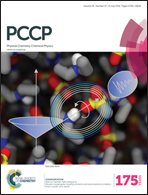Nano-size scaling of alloy intra-particle vs. inter-particle separation transitions: prediction of distinctly interface-affected critical behaviour†
Abstract
Phase-separation second-order transitions in binary alloy particles consisting of ∼1000 up to ∼70 000 atoms (∼1–10 nm) are modeled focusing on the unexplored issue of finite-size scaling in such systems, particularly on evaluation of correlation-length critical exponents. Our statistical-thermodynamic approach is based on mean-field analytical expression for the Ising model free energy that facilitates highly efficient computations furnishing comprehensive data for fcc rectangular nanoparticles (NPs). These are summed up in intra- and inter-particle scaling plots as well as in nanophase separation diagrams. Temperature-induced variations in the interface thickness in Janus-type intra-particle configurations and NP size-dependent shifts in the critical temperature of their transition to solid-solution reflect power-law behavior with the same critical exponent, ν = 0.83. It is attributed to dominant interfacial effects that are absent in inter-particle transitions. Variations in ν with nano-size, as revealed by a refined analysis, are linearly extrapolated in order to bridge the gap to larger particles within and well beyond the nanoscale, ultimately yielding ν = 1.0. Besides these findings, the study indicates the key role of the surface-area to volume ratio as an effective linear size, revealing a universal, particle-shape independent, nanoscaling of the critical-temperature shifts.


 Please wait while we load your content...
Please wait while we load your content...